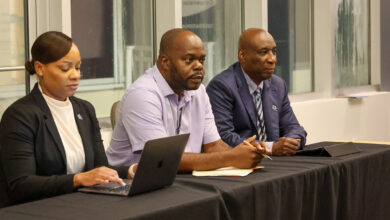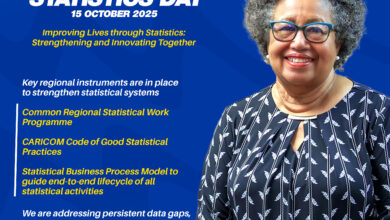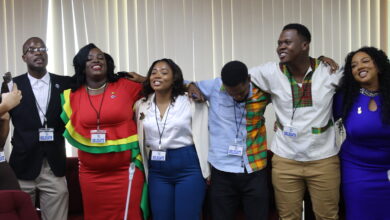|
His Excellency Mr. Bharrat Jagdeo It is a great pleasure for me to be with you this evening at this joyous, Yuletide season but not necessarily to be addressing you on the type of serious subject which the distinguished President of the Georgetown Chamber of Commerce and Industry has asked of me. But my friends, as you and I know there is no such thing as a free lunch – or dinner for that matter. Indeed it would have been surprising if I were to decline a request from you, when in this year alone I have already addressed similar organisations such as the Montego Bay, Chamber, the Trinidad and Tobago Manufacturers Association and the Caribbean Association of Industry and Commerce. To have said no to the Georgetown Chamber would have been unthinkable, sacrilegious even. The increasing interest being shown by the private sector in the process of regional integration is a most healthy sign as is the increasing interaction between the regional public and private sectors. In this era, there is now a general understanding and acceptance that no one group nor sector can successfully move our region into a condition of viability and prosperity or indeed save it from marginalisation. It is an awareness, now shared by all – the private sector, the public sector, labour movement, non-governmental organisations and the civil society at large. The Community has therefore stepped up its drive to be all-inclusive as it seeks to ensure the widest possible consensus and participation in the development of the regional economy and society. And the greatest evidence of this thrust was right here in Georgetown in July this year when the unique and historic “Forward Together” Conference was held. Side by side, our Leaders and representatives of civil society exchanged views, with no holds barred, on the way forward for our Community. Out of those discussions emerged a landmark document known as the Liliendaal Statement of Principles committing the political leadership of the Community to continuous dialogue with civil society in further developing the regional integration process. Against this background, this evening’s invitation is especially welcome, allowing me as it does to interact with the captains of industry and commerce in Guyana, the headquarters of the Caribbean Community. The chosen theme also allows me to return to a question that is being increasingly asked not only by the business community but indeed by all the stakeholders in our Community. That question is: “CARICOM – What is in it for us?” Given the sumptuous fare which we have all just enjoyed, it is tempting to say in response to the question –‘a lot” – and sit down, drink in the ambience and bask in the glow of the festive season. But alas no such luck! Mr. Chairman, Ladies and Gentlemen, the first point I wish to stress is that we all need to realise that CARICOM is all of us. This therefore leads to the conclusion that what is in it for us is directly related to what we put into it – [ it is not a lottery – you cannot win more than you invest]. As businessmen you more than anyone else know that your returns are in proportion to your effort. At the end of my presentation therefore, I hope you would no longer be asking what’s in it for us, but what’s in us for it – that is – what have we, what can we, what will we put into it because it is that which will ultimately determine what we get out of it – in other words – what’s in it for us? Let’s look at the picture. As you know, CARICOM, and before it CARIFTA, provided for free trade in goods originating from within the Community – no duties, no quotas – among the Member States of the grouping. From the standpoint of Guyana, with its abundant natural resource endowment, including vast tracts of quality agricultural land, you are undoubtedly among the best placed to supply the basic food and shelter requirements of the entire Caribbean Community. Are you satisfied that you have put the most into supplying those needs in order to get what’s in it for you? This of course is a judgement you alone can make. I am not unaware of the significant problems in the way of achieving such an objective. But have all efforts been truly made? Have all options been explored – joint ventures, mergers, alliances, etc? Have satisfactory standards been always maintained? Have you employed all your commercial and political savoir faire? These are questions only you can answer. But you must answer. As the headquarters, Guyana is particularly well placed within the Caribbean Community to seize the initiative to confront and have resolved such obstacles as stand In the way of it achieving a pre-eminent place in the economic life of the Community. With an assured market of six million – and soon to be 15 million with Haiti’s inclusion – CARICOM provides Guyana, and every other Member State with a vital training ground in developing its diplomatic, commercial and marketing skills necessary to compete successfully in the wider global market place. Indeed, as Mr. Jimmy Moss-Solomon, a Grace Kennedy executive and now Private Sector advisor to the Caribbean Regional Negotiating Machinery stated earlier this year in referring to the CARICOM Single Market and Economy that though not a panacea the Single Market is “an important practice match.” And then stressed “ We are about to enter the World Cup of international trade. The CSME is a dress rehearsal for relatively small domestic firms and industries before they begin to compete against large firms in the 34 -member FTAA.” What is in it for us? What are we prepared to put into it? CARICOM is fast moving to become a Single Market and Economy. This, as regards trade, will add to the original emphasis on free trade in goods by providing for free trade in services as well. Are CARICOM Member States prepared for this evolution? Is Guyana prepared for this evolution? For even though Guyana’s strengths obviously lie in the production and trade in goods, it would seem to me that it would not be prudent to ignore the significant possibilities it has for the development of services and of trade therein, including those flowing from having the headquarters of the Community and most of its meetings here and eco-tourism endowments as well. In the pursuit of that CSME, which in addition to the free movement of goods, also involves the free movement of capital and the right to establish businesses throughout the Community as a national of any country, our research has found standing in the way of its achievement some 350 restrictions, taking all Member States together. A process of negotiation has been entered into with each Member State and a programme for the removal of these restrictions has been agreed on with each Member State. The time- table for the removal of these restrictions is as follows: the first batch will be removed by the end of 2003; the second by the end of 2004 and the final by the end of 2005, heralding the Single Market and Economy. In this process of dismantling the restrictions, some countries have opted to front load the honouring of their obligations by removing the bulk of their restrictions in the earlier years, leaving very few for the last year. Others have chosen the opposite approach. These time-tablings can have important implications for advantages in the development of the Single Market. Using skills, a known indispensable element for economic development, as an example, if a country chooses to maintain restrictions on the free entry of skilled personnel until 2005 and another opts to remove such restrictions at the first tranche in 2003, then there will always be the possibility of skilled personnel moving to the country to which free entry is earliest available. There is a danger that such movement may be from the country, which will not be open to free entry of such skills until after 2005. In other words the front loader may gain at the expense of the back-loaders. I am sure that Guyana would want to look at this matter to ensure that it will be among the front loaders rather than the back-loaders in this regard. Of course every country is free to advance its time-table. The CSME provides the opportunity for increasing production levels as well as an incentive to foster competitiveness. Some businesses, particularly in Trinidad and Tobago, have already been re-organising and restructuring their operations to increase productivity and improve efficiency. They have been consolidating their position in the domestic and regional markets through alliances, takeovers and regional expansion, notably in the financial services sector, the distributive trades and also in manufacturing. You in Guyana may wish to carefully study and where possible, adopt and/or adapt the strategies of your neighbour in areas where you identify your competitive advantage. In seeking to take advantage of the Community-wide opportunities offered by the CSME, your confidence can be re-enforced by the soon to be brought into existence of the Caribbean Court of Justice, which in the exercise of its original jurisdiction will provide the necessary legal certainty required for a stable investment climate and for contributing to regional macro‑economic stability. Also the functioning of CROSQ will provide a viable support as regards the important question of standards, which is indispensable for competitive production. Mr. Chairman, Ladies and Gentlemen, as you are aware CARICOM is more than economic integration. Indeed, some of its greatest successes and major benefits received by all as a Region, have come in the non-economic areas such as foreign-policy co-ordination and functional co-operation, including health and education. But tonight our focus will continue to be on trade and economic dimension. Let us now turn to the trade and economic benefits, which CARICOM provides beyond its border – as it were. In this regard, reference is made to the trade agreements entered into with Venezuela, Colombia, Dominican Republic and Cuba, providing external markets of some 80 odd million (84 million). This will soon be expanded closer to 90 odd million (88 million) when the free trade agreement with Costa Rica, now being negotiated is concluded. This, Ladies and Gentlemen taking in to account CARICOM’s own market, provides a market opportunity of more than 100 million (104 million) for any CARICOM producer, including you here in Guyana. That is the good news. The bad news is that, first of all, you have to be competitive to exploit such market opportunities and secondly just as those market opportunities are open to you, your markets are now open to all those others. What’s in it for you? What you put into it. I am afraid that our record in this regard does not look too good – so far. Mr Chamber President you will recall that we were together in Colombia in February this year where we came face to face with the stark reality that for the first five years after the CARICOM/Colombia Trade Agreement came into force, CARICOM exports to that market had increased by approximately $5 million (US) while that country’s exports to CARICOM had increased by approximately $674 million (US). This has set me to wonder: Are we ready to take advantage of what’s in it for us? In addition to these agreements, there is of course the ACP/EU arrangement, which was spearheaded in large measure by CARICOM as part of the ACP Group of States, and which for more than 25 years has provided the backbone for some of our major exports, in the case of Guyana, sugar, rum and rice – in addition to financial assistance. But this vital backbone is crumbling. The Region knows well the story of bananas and we are all aware of the spectre of a threat to sugar.– oddly enough by countries who are our friends!! Rice, well we’re not too sure and rum, after being dealt a near fatal body blow is fighting a valiant battle with some help from the EU, 70 million Euros. These ladies and gentlemen are clear signs to the future and what we will get out of that future depends on what we put into the battle now. In other words how well we grasp the opportunities, which are still available. Within this ACP/EU arrangement, in its most recent form, the Cotonou Agreement – there is an important business financing facility, which you as businessmen should certainly know of and may wish to explore and exploit. This is the Euro 2.2 billion (currently just over US $2 billion) investment facility to help develop businesses in ACP countries. This Facility is designed to finance income earning, commercially and economically viable private businesses and, where these requirements are met, public enterprises as well. Businesses would have direct access to the Facility, or indirectly, through intermediaries. Its focus will be basically on fields of intervention and operations, which are unlikely to attract private capital or support from local financial institutions – in other words, it is for medium and long-term financing, risk capital and flanking measures such as guarantee funds. This Facility will be able to invest in the form of loans, equity and quasi-equity and it will also be able to write guarantees in support of domestic and foreign private investment. CARICOM – what is in it for us! Perhaps one of the most influential ways in which CARICOM is seeking to safeguard and pursue the regional interest within the global economy is through the functioning of the Regional Negotiating Machinery to negotiate trade agreements on behalf of the entire Region. The objective of this Machinery is as much to negotiate adequate protection of our sensitive industries, as well as to win markets and opportunities for our new and dynamic enterprises. It is an instrument, which must therefore work hand in hand with the Regional private sector. To date there has been some limited success exemplified by the United States’ acceptance of the region’s case for special and differential treatment for small states in the FTAA. As the series of negotiations – in the FTAA, in the WTO and the ACP/EU arrangement gather pace, it is vital that all hands – private sector, public sector, RNM and the wider civil society – join together in forging the strongest possible Caribbean negotiating position. What’s in it for us? What we put into it. At the end of the day – and indeed perhaps well before the end of the day – it is more than reasonable for you to ask “what’s in it for us”. More specifically how can we benefit from these various trade and economic arrangements. First of all you need to know what they contain, because if you are not aware of what’s in them you cannot be expected to effectively exploit them. To bridge this knowledge gap and to enhance the extent to which we as a region can exploit these various arrangements, some specific mechanism must be put in place. As a start, I have recruited at the Secretariat, an officer whose primary duties include private sector facilitation and generally catering to the needs of the private sector including addressing specific problems of small private sector companies. I urge you to make good use of her services. The time has also come for the private sector at national levels to establish some small permanent technical unit to look after its affairs as a sector. Such a unit working with our officer and in co-ordination with regional private sector bodies such as the CAIC and regional public sector bodies, such as the RNM and Carib Export can help to undertake a number of strategic tasks required by various segments of the private sector. This is particularly important for the small business sub-sector, which constitutes a significant and vital part of all our economies. Given our experience with the various trade agreements, for example, of limited implementation, I would venture to suggest that the time is opportune for the organisation by such a unit of a workshop-type review of all these agreements to assess exactly how we have been performing, what have been the obstacles to effective implementation on our part, what are the particular products involved, what are the difficulties in regard to finance, transportation, standards, packaging etc. and most critically what needs to be done to correct these deficiencies where they exist. Such a review would provide us with a better understanding of what is in it for us and what we need to put in to get it. Important, valuable and even indispensable as the above undoubtedly is, it is not all that is required of us. One does not have to be a visionary to recognise that the historical base of Caribbean economies and traditional major external sources of impulse for their growth and development have been waning. One also does not have to be a visionary to recognise that that process will continue. The time has therefore come for the Caribbean – at all levels – to seek to construct new bases for the economy and a new dynamo for its growth and development. The Rt. Hon. Owen Arthur, the distinguished Prime Minister of Barbados, and an outstanding economist in his own right, had this to say when he addressed the Third Summit of Heads of State and Government of the Association of Caribbean States, in Margarita last December:
CARICOM has been instrumental in designing the bricks for the building of this new economic edifice – it is upgrading itself into a Single Market and Economy with the evident economic and other benefits which flow there from; it has, as we have shown, established trade and economic agreements with a large number of countries in the greater Caribbean; it is preparing itself for participation in the FTAA, thereby laying the foundation for greater linkages with other countries in the Central and Latin American region and it is seeking to refurbish and modernise its traditional relations with Europe. Many of the elements needed for the creation of a new dynamo are therefore either in place or and being forged. The shift of emphasis is already taking place as trade with the greater Caribbean Region seems set to assume greater significance. Now what is in all this for us? Certainly it depends on what we put into it at all levels, the political directorate, the private sector, the public sector, the NGOs and the wider civil society. In this task, we particularly must come to grips with the problem of crime in all our societies and the necessity to review forms of governance to enhance stability in many of our states. Ladies and Gentlemen, the time has come for all of us to don the mantle of architects of a new Caribbean economy and society. – some would say a new Caribbean Civilisation! Let there be no doubt however, that in such an historic effort, the private sector’s role is decisive and in that role you the members of the Guyana private sector cannot afford to shirk your historic responsibility. What’s in it for you? – the very maintenance and survival of our Caribbean society. Ladies and Gentlemen, I think I can honestly say that as CARICOM approaches its 30th Anniversary, despite some setbacks, there is much for all of us to be proud of. It has done enough to justify the saying that if it were not here, we would have had to create it. We at the Secretariat are thankful that we have been afforded the opportunity to contribute to this process and thanks to the governments of Guyana and Japan, we look forward to the completion of our new headquarters in December 2003, which will itself greatly assist in the enhancement of our effectiveness in serving the Community, including the private sector. Amidst all these various regional, hemispheric and international currents, you the members of the private sector – to whom I once again my thanks and appreciation for having invited me to address you this evening – must remain focused and keep your eyes on the grand prize – a viable, secure and prosperous Caribbean Community. That’s what’s in it for you and for all of us! And it can be achieved by dedicated efforts. In this festive season, on behalf of myself, the management and staff of the CARICOM Secretariat, I wish to extend to you, your families and indeed the entire Guyanese community, best wishes for a blessed Christmas and a New Year filled with health, stability and prosperity. Thank you ladies and Gentlemen. |
|
Press ReleasesSpeeches





